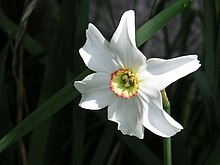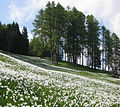Narcissus poeticus
| Narcissus poeticus | |
|---|---|

| |
| Scientific classification | |
| Kingdom: | Plantae |
| Clade: | Tracheophytes |
| Clade: | Angiosperms |
| Clade: | Monocots |
| Order: | Asparagales |
| Family: | Amaryllidaceae |
| Subfamily: | Amaryllidoideae |
| Genus: | Narcissus |
| Species: | N. poeticus
|
| Binomial name | |
| Narcissus poeticus L., 1753
| |
Narcissus poeticus (Poet's Daffodil, Nargis, Pheasant's Eye, Findern Flower, and Pinkster Lily) was one of the first daffodils to be cultivated, and is frequently identified as the narcissus of ancient times[1][2]—often associated with the Greek legend of Narcissus.[3][4] Extremely fragrant, with a ring of petals in pure white and a short corona of light yellow with a distinct reddish edge,[5] Poet's Daffodil grows to 20 to 40 cm (7.9 to 15.7 in) tall and is widely naturalized in North America and Europe.[6]
Use in perfume
Poet's Daffodil is cultivated in Holland and southern France for its essential oil, narcissus oil, one of the most popular fragrances used in perfumes. Narcissus oil is used as a principal ingredient in 11% of modern quality perfumes—including 'Fatale' and 'Samsara'—as a floral concrete or absolute. The oil's fragrance resembles a combination of jasmine and hyacinth.[2]
Legend and history


The earliest mention of Poet's Daffodil is likely in the botanical writings of Theophrastus (371 – c. 287 BCE), who wrote about a spring-blooming narcissus that the Loeb Classical Library editors identify as Narcissus poeticus.[7] The poet Virgil, in his fifth Eclogue, also wrote about a narcissus whose description corresponds with that of Narcissus poeticus.[8] In one version of the myth about the Greek hero Narcissus, he was punished by the Goddess of vengeance, Nemesis, who turned him into a Narcissus flower that historians associate with Narcissus poeticus.[4][9] The fragrant Narcissus poeticus has also been recognized as the flower that Persephone and her companions were gathering when Hades abducted her into the Underworld, according to Hellmut Baumann in The Greek Plant World in Myth, Art, and Literature. This myth accounts for the custom, which has lasted into modern times, of decorating graves with these flowers.[10] Linnaeus, who gave the flower its name, quite possibly did so because he believed it was the one that inspired the tale of Narcissus, handed down by poets since ancient times.[11]
In medicine, it was described by Dioscorides in his Materia Medica as "Being laid on with Loliacean meal, & honey it draws out splinters".[12] James Sutherland also mentioned it in his Hortus Medicus Edinburgensis.[13]
N. poeticus has long been cultivated in Europe. According to one legend, it was brought back to England from the crusades by Sir Geoffrey de Fynderne.[14] It was still abundant in 1860 when historian Bernard Burke visited the village of Findern—where it still grows in certain gardens and has become an emblem of the village.[15] It was introduced to America by the late 18th century,[16] when Bernard McMahon of Philadelphia offered it among his narcissus. It may be the "sweet white narcissus" that Peter Collinson sent John Bartram in Philadelphia, only to be told that it was already common in Pennsylvania, having spread from its introduction by early settlers.[17]
Narcissus poeticus has long been hybridized with the wild British daffodil Narcissus pseudonarcissus, producing many named hybrids. These older heritage hybrids tend to be more elegant and graceful than modern hybrid daffodils, and are becoming available in the UK once again.[18]
Toxicity
While all narcissi are poisonous when eaten, Poet's Daffodil is more dangerous than others, acting as a strong emetic and irritant.[19] The scent is powerful enough that it can cause headache and vomiting if a large quantity is kept in a closed room.[20]
Photo gallery
-
Field of naturalized N. poeticus in Slovenia
Notes
- ^ Narcissus tazetta and Narcissus jonquilla have also been considered as possibilities.
- ^ a b Groom, Nigel (1997). The New Perfume Handbook. Springer. p. 225. ISBN 9780751404036.
- ^ Peavy, Charles D. (Jul.-Sept., 1966). "Faulkner's Use of Folklore in The Sound and the Fury". The Journal of American Folklore. 79 (313). American Folklore Society: 437–447. doi:10.2307/537508.
{{cite journal}}: Check date values in:|date=(help) - ^ a b Lehner, Ernst (1990). Folklore and Symbolism of Flowers, Plants, and Trees. Omnigraphics. p. 73. ISBN 9781558888869.
{{cite book}}: Unknown parameter|coauthors=ignored (|author=suggested) (help) - ^ Woodhead, Eileen (1998). Early Canadian Gardening. McGill-Queen's Press – MQUP. p. 171. ISBN 9780773517318.
{{cite book}}: Unknown parameter|coauthors=ignored (|author=suggested) (help) - ^ "Narcissus poetica". Flora of North America. Retrieved 2008-12-25.
- ^ Jashemski, Wilhelmina Mary Feemster (2002). The Natural History of Pompeii: A Systematic Survey. Cambridge University Press. p. 131. ISBN 9780521800549.
{{cite book}}: Unknown parameter|coauthors=ignored (|author=suggested) (help) - ^ Bourne, Stephen Eugene (1903). The Book of the Daffodil. J. Lane. p. 3.
{{cite book}}: Unknown parameter|coauthors=ignored (|author=suggested) (help) - ^ "In the classic myth, Nemesis, the deity of vengeance, complying with Hera's order to punish Narcissus for his egotism, turns him into the narcissus flower (narcissus poeticus)" Peavy, p. 438.
- ^ Taken from Baumann, Hellmut, The Greek Plant World in Myth, Art, and Literature, London: The Herbert Press; 1993. Cited in Dafni, Amots (2006-09-10). "Ritual plants of Muslim graveyards in northern Israel". Journal of Ethnobiology and Ethnomedicine. 2 (38): 38. doi:10.1186/1746-4269-2-38. PMC 1584233. PMID 16961931.
{{cite journal}}:|access-date=requires|url=(help); Unknown parameter|coauthors=ignored (|author=suggested) (help)CS1 maint: unflagged free DOI (link) - ^ Allen, Ray. "Daffodils – the Flower that Means Spring!". Floridata. Retrieved 2008-12-26.
- ^ Eastwood, Dr M A Eastwood. "The Sibbald Physic Garden". History of Medicine. Royal College of Physicians of Edinburgh. Retrieved 2008-12-26. [dead link]
- ^ Robertson, Forbes W. (Winter, 2001). "James Sutherland's "Hortus Medicus Edinburgensis" (1683)". Garden History. 29 (2). The Garden History Society: 144.
{{cite journal}}: Check date values in:|date=(help) - ^ The Christian. Morgan and Scott. 1871.
- ^ "Welcome to Findern". Findern Parish Council. Retrieved 2008-12-26. [dead link]
- ^ Taylor, Raymond L. (1996). Plants of Colonial Days. Courier Dover Publications. p. 68. ISBN 9780486294049.
- ^ Ann Leighton, American Gardens in the Eighteenth Century: 'For Use or for Delight' (University of Massachusetts Press) 1986:459.
- ^ Kingsbury, Noel (2008-03-20). "Narcissus: Old gold". telegraph.co.uk. Retrieved 2008-12-26.
- ^ Hanks, Gordon R. (2002). Narcissus and Daffodil: The Genus Narcissus. CRC Press. p. 27. ISBN 9780415273442.
- ^ Grieve, Maud (1971). A Modern Herbal. Courier Dover Publications. p. 573. ISBN 9780486227993.
{{cite book}}: Unknown parameter|coauthors=ignored (|author=suggested) (help)



